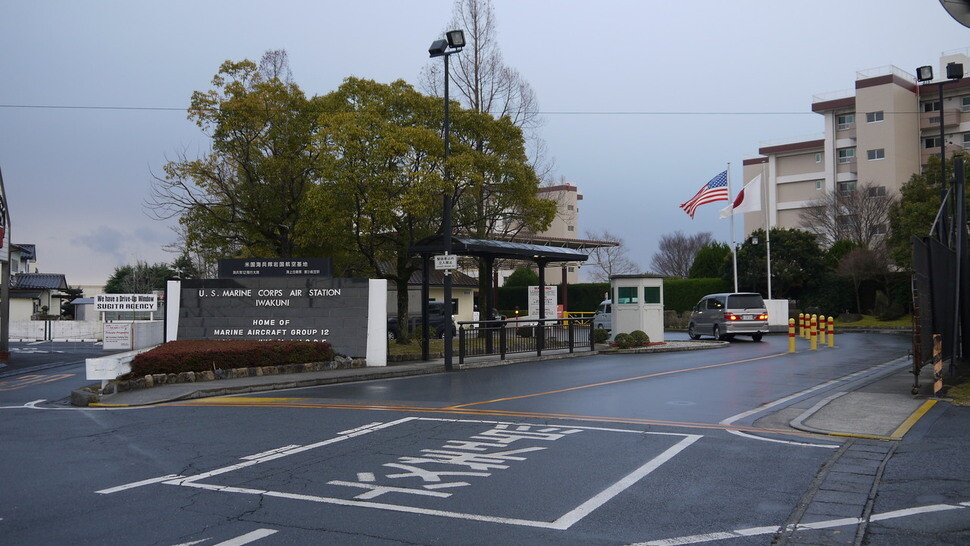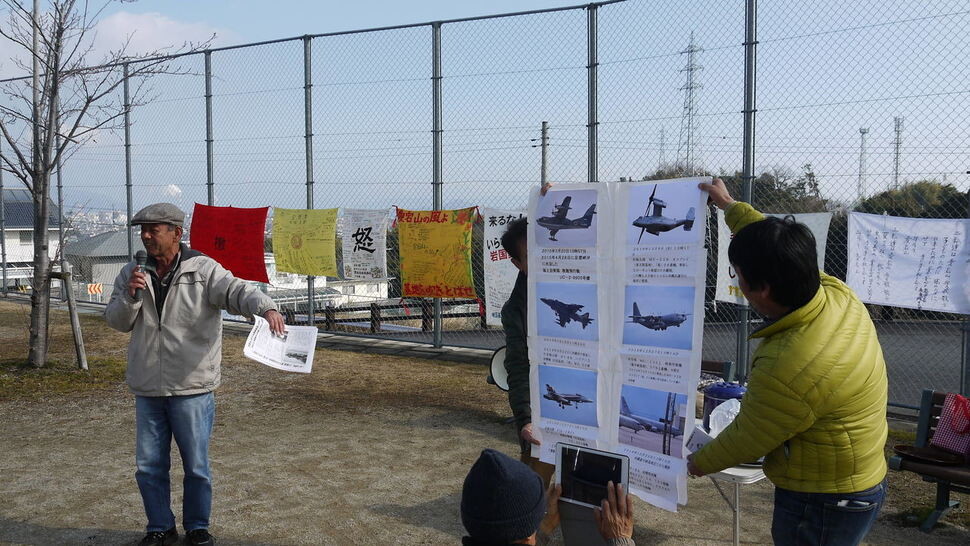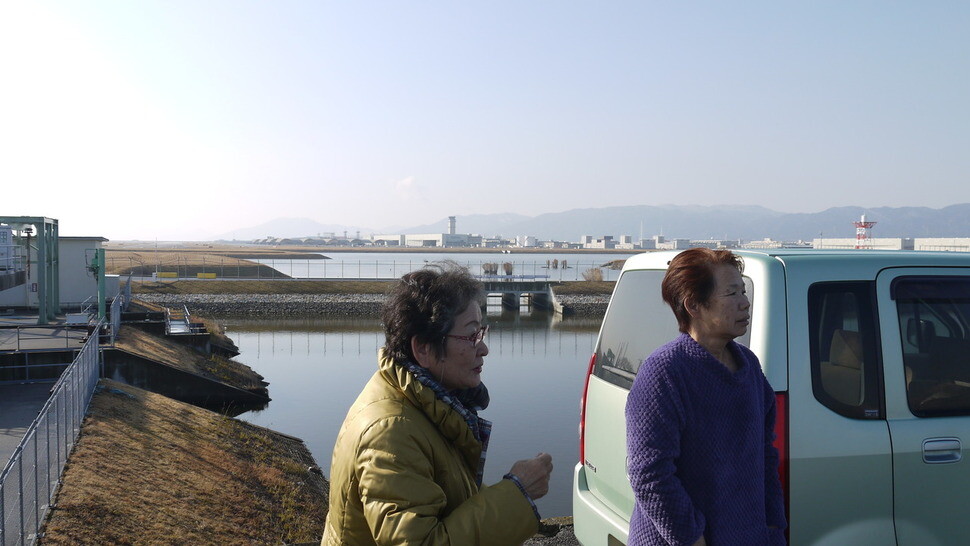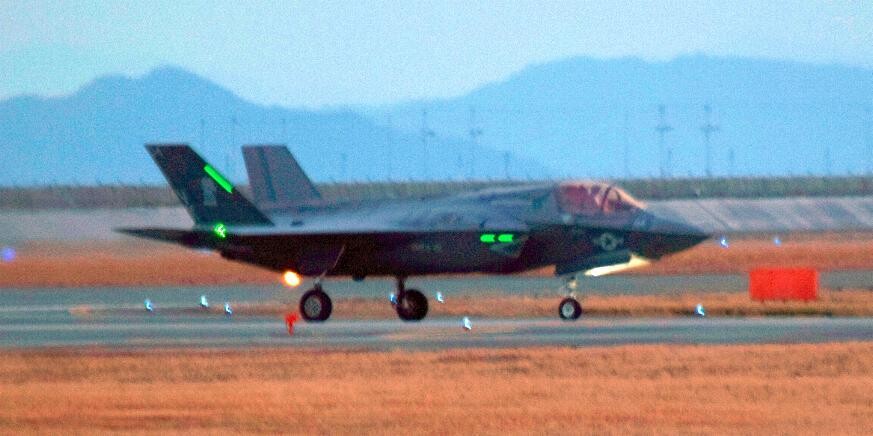hankyoreh
Links to other country sites 다른 나라 사이트 링크
[Reportage] Japan’s Iwakuni becoming biggest US military base in East Asia

Standing atop an embankment with a good view of the runway of Marine Corps Air Station Iwakuni at 10 am on Jan. 21, Akiko Onishi, 72, a nine-term member of the Iwakuni city council, pointed in the direction of the base and began to explain: “This is Saturday, which is a day off for the US military. It doesn’t look like any extra F-35Bs will be dispatched today. On the afternoon of Jan. 18, when the first two arrived, everyone was up here taking pictures,” Onishi said.
Iwakuni base in Yamaguchi Prefecture, which is turning into the largest military base in East Asia, is on the beach, facing the Seto Inland Sea. Located in the delta formed where the Monzen River and the Imazu River flow east through downtown Iwakuni into the sea, the base includes a massive runway that is 2,440 meters long and 60 meters wide.

In one corner of the base, there was a distinctive round hanger that could hold a single fighter at a time. Beneath the hanger was the small squat black object. This was the marines‘ top-of-the-line stealth fighter, the F-35B, which is expected to bring a sea change to the strategic balance in East Asia, amid an intensifying confrontation between China and the US-Japan alliance.
“While people on the outside are interested in the deployment of the F-35B, from the perspective of residents in the area, the real problem begins now,” Onishi said. As part of the US Forces Japan reorganization plan confirmed in May 2006, Carrier Air Wing Five (CVW-5, the unit of aircraft based on the USS Ronald Reagan aircraft carrier) will be relocated here from their current position at Naval Air Facility Atsugi in Kanagawa Prefecture in three phases from Nov. 2017 until May 2018.
At the moment, Iwakuni is the home of Marine Aircraft Group 12, which includes attack aircraft such as the FA-18 Super Hornet and the AV-8 Harrier, which is capable of vertical take-off and landing. Once Iwakuni is augmented with Carrier Air Wing Five, the air power stationed there will increase to 120 or 130 aircraft, which is twice the current level. It will essentially become the largest military base in East Asia, even surpassing Kadena Air Base on Okinawa, which has 100 or so aircraft. The F-35Bs and the US aircraft carrier battle group that are forward-deployed against China can now intervene more rapidly in various incidents in East Asia, from the Korean Peninsula to the South China Sea.

The interesting thing is how the residents’ are reacting. When I asked the people I met to share their opinion about the fact that the military base there was becoming the largest in East Asia, the typical response I got was, “You‘re right. It’s a big deal.” It was hard to find anyone who would come out and express their opposition.
“The people here have a lot of pride that they were the ones who have led Japan since the Meiji Restoration. Eight prime ministers have come from the region, so they cooperate with the state in all matters,” said Hiroshi Okamura, 73, leader of a local civic group called Defenders of Atagoyama.
The area was represented by Nobusuke Kishi, current Prime Minister Shinzo Abe‘s maternal grandfather, and by Eisaku Sato, Abe’s maternal great uncle. The current lawmaker from the area is State Minister for Foreign Affairs Nobuo Kishi, Abe’s younger brother.

But that doesn’t mean the residents welcome the base getting bigger or taking on a bigger role. When residents were asked in a referendum in March 2006, while Katsusuke Ihara was mayor, whether they supported the relocation of the US military base, 90% said they opposed it.
To force Ihara to yield, the Japanese government suspended a promised payment of 3.5 billion yen (US$31 million) in subsidies for a government office in Dec. 2006. In Feb. 2008, Ihara resigned and ran again in the next election, in a bid to confirm voters‘ confidence, but he was narrowly defeated by Fukuda Yosihiko, the current mayor, who resigned as a lawmaker in the Diet to join the race. After that, an area around Atago Mountain that was supposed to be a housing development for residents was repurposed as a luxury residence for US military officers who were moving there, and construction has been underway for some time now.
Iwakuni is currently abuzz about the grants the Japanese government is giving as an incentive for the base renovation. A new incineration plant and a fire prevention center have gone up in town, and a tourism facility has also been built for the “sirohebi,” a white snake native to the area that is considered a “natural monument.”
“Damage from the US troops stationed here is going to increase rapidly. We need to be fighting this now instead of thinking it’s too late. The Japanese need to learn from the fighting spirit shown by the residents of Seongju County in South Korea [the deployment site for the THAAD missile defense system],” said Kazushi Matsuda, 59, who is taking part in a campaign of opposition to the US military base.

By Gil Yun-hyung, Tokyo correspondent
Please direct questions or comments to [english@hani.co.kr]

Editorial・opinion
![[Editorial] Yoon must halt procurement of SM-3 interceptor missiles [Editorial] Yoon must halt procurement of SM-3 interceptor missiles](https://flexible.img.hani.co.kr/flexible/normal/500/300/imgdb/child/2024/0501/17145495551605_1717145495195344.jpg) [Editorial] Yoon must halt procurement of SM-3 interceptor missiles
[Editorial] Yoon must halt procurement of SM-3 interceptor missiles![[Guest essay] Maybe Korea’s rapid population decline is an opportunity, not a crisis [Guest essay] Maybe Korea’s rapid population decline is an opportunity, not a crisis](https://flexible.img.hani.co.kr/flexible/normal/500/300/imgdb/original/2024/0430/9417144634983596.jpg) [Guest essay] Maybe Korea’s rapid population decline is an opportunity, not a crisis
[Guest essay] Maybe Korea’s rapid population decline is an opportunity, not a crisis- [Column] Can Yoon steer diplomacy with Russia, China back on track?
- [Column] Season 2 of special prosecutor probe may be coming to Korea soon
- [Column] Park Geun-hye déjà vu in Yoon Suk-yeol
- [Editorial] New weight of N. Korea’s nuclear threats makes dialogue all the more urgent
- [Guest essay] The real reason Korea’s new right wants to dub Rhee a founding father
- [Column] ‘Choson’: Is it time we start referring to N. Korea in its own terms?
- [Editorial] Japan’s rewriting of history with Korea has gone too far
- [Column] The president’s questionable capacity for dialogue
Most viewed articles
- 1Months and months of overdue wages are pushing migrant workers in Korea into debt
- 2At heart of West’s handwringing over Chinese ‘overcapacity,’ a battle to lead key future industries
- 3Under conservative chief, Korea’s TRC brands teenage wartime massacre victims as traitors
- 4[Guest essay] Maybe Korea’s rapid population decline is an opportunity, not a crisis
- 51 in 3 S. Korean security experts support nuclear armament, CSIS finds
- 6Fruitless Yoon-Lee summit inflames partisan tensions in Korea
- 7Trump asks why US would defend Korea, hints at hiking Seoul’s defense cost burden
- 8[Editorial] Yoon must halt procurement of SM-3 interceptor missiles
- 9Dermatology, plastic surgery drove record medical tourism to Korea in 2023
- 10First meeting between Yoon, Lee in 2 years ends without compromise or agreement